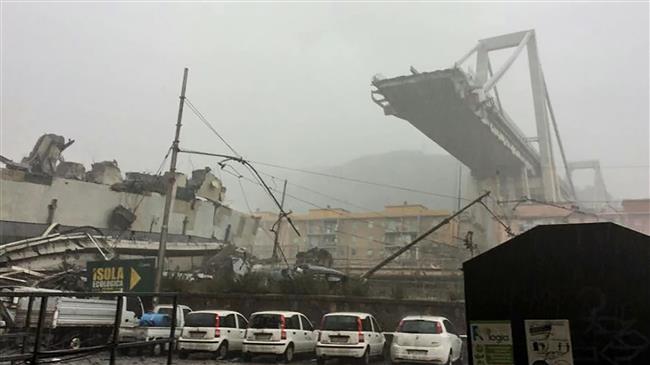Italy to probe bridge collapse, death toll hits 38
Italian prosecutors plan to launch an investigation into the collapse of a bridge that has left at least 38 people dead in northwestern Italy, as rescuers continue searching for possible survivors.
A major section of Italy’s towering A10 highway bridge — also known as the Morandi motorway bridge — in the city of Genoa disintegrated on Tuesday morning during a strong thunderstorm, sending vehicles plunging nearly 91 meters to the ground.
At least 30 vehicles were on the bridge when the span gave way, said a local firefighter, Amalia Tedeschi, as quoted in a report by the Italian news agency ANSA. He added that several people were pulled from the rubble alive and taken to a hospital by helicopter.
Rescue operations continued into Wednesday morning, with aerial footage from Italy’s National Fire Corps showing cranes excavating under the rubble in an effort to find more victims and possibly survivors.

Authorities have said the casualty toll may increase.
Italian Interior Minister Matteo Salvini said nearly 200 firefighters were on the scene searching for potential survivors.
At least 38 people, including a child, were killed in the accident, according to authorities.
Some of the wounded are reportedly in critical condition.
All the casualties appeared to have been in vehicles that plunged from the bridge, said Director of Italy’s Civil Protection Agency Angelo Borelli during a news conference. He said the bridge fell on two warehouses but no one was likely inside them since they were closed for the summer holidays.
Borelli said 30 to 35 vehicles, including three heavy trucks, were on the bridge at the time of the collapse.

While the cause of the collapse is still under investigation, corrosion, construction work on the bridge involving a crane at the time of the incident, and a lightning strike have been reported as potential factors.
The 51-year-old structure, designed by celebrated Italian engineer Riccardo Morandi, had been beset by problems since its construction in the 1960s, leading to costly maintenance work and drawing criticism from engineering experts.
Reacting to the tragedy, Italy’s Prime Minister Giuseppe Conte said “all infrastructure” across the country needed to be double-checked, emphasizing, “We must not allow another tragedy like this to happen again.”

Transport Minister Danilo Toninelli said the collapse was “unacceptable,” insisting that if negligence played a role, “whoever made a mistake must pay.”
According to Toninelli, the company that has the concession to operate that section of the highway said its maintenance on the bridge was up to date and no work was being done at the time of the collapse. He said, however, that they were about to launch a 20-million-euro bidding process for significant safety work on the bridge.
“There has not been sufficient maintenance and checks and safety work for many bridges and viaducts and bridges in Italy constructed — almost all — during the 1960s,” he said.
The Italian CNR civil engineering society was cited in press reports as saying that structures as old as the Morandi bridge had exceeded their lifespan.
Source: Presstv




